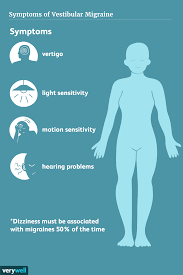
Vestibular migraine (VM) is vertigo with migraine, either as a symptom of migraine or as a related neurological disorder.
Vestibular migraine is a distinct migraine phenotype.
Epidemiological studies indicate a strong link between vertigo and migraine.
Vertigo is a symptom of a vestibular system disturbance, and includes a feeling of rotation or illusory sensations of motion or both.
Motion sickness occurs more frequently in migraine patients,at 30–50% more than in controls.
Benign paroxysmal vertigo of childhood is an example of migraine-associated vertigo in which headache does not often occur.
Basilar artery migraine (BAM) has two or more symptoms of vertigo, tinnitus, decreased hearing, ataxia, dysarthria, visual symptoms in both hemifields or both eyes, diplopia, bilateral paresthesias, paresis, decreased consciousness and/or loss of consciousness followed by throbbing headache.
Fluctuating low-tone sensorineural hearing loss in more than 50% of patients with BAM with a noticeable change in hearing just before the onset of a migraine headache.
The attacks of vertigo are usually concurrent with a headache and the family history is usually positive.
Familial vestibulopathy, familial benign recurrent vertigo, where episodes of vertigo occur with or without a migraine headache.
The syndrome responds to acetazolamide.
Familial hemiplegic migraine (FHM) has been linked to mutations in the calcium channel gene.
The pathophysiology of migraine associated vertigo is not completely understood; both central and peripheral defects have been observed.
The diagnostic criteria of vestibular migraine are:
At least 5 episodes with vestibular symptoms of moderate or severe intensity, lasting 5 minutes to 72 hours
Current or previous history of migraine with or without aura.
One or more migraine features with at least 50% of the vestibular episodes:
headache with at least two of the following characteristics: one sided location, pulsating quality, moderate or severe pain intensity, aggravation by routine physical activity
photophobia and phonophobia
visual aura
Not better accounted for by another vestibular or headache disorder diagnosis/
Migraine is commonly associated with BPPV, the most common vestibular disorder in patients presenting with dizziness.
The two may be linked by genetic factors or by vascular damage to the labyrinth.
There is an increased prevalence of migraine in patients with Ménière’s disease and migraine leads to a greater susceptibility of developing Ménière’s disease.
But they can be distinguished. Ménière’s disease may go on for days or even years, while migraines typically do not last longer than 24 hours.
Motion sickness is more prevalent in patients with migraine.
Dizziness and spinning vertigo are the second most common symptom of panic attacks, and they can also present as a symptom of major depression.
Migraine is a risk factor for developing major depression and panic disorder and vice versa.
Treatment of migraine-associated vertigo is the same as the treatment for migraine in general.
Migraine patients reported 2.5 times more vertigo and also 2.5 more dizzy spells during headache-free periods than the controls.
Migraine associated vertigo may occur at any age with a female:male ratio of between 1.5 and 5:1.
Familial occurrence is not uncommon.
In most patients, migraine headaches begin earlier in life than migraine associated vertigo with years of headache-free periods before MAV manifests.
